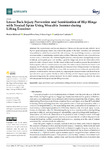Mostrar o rexistro simple do ítem
Lower Back Injury Prevention and Sensitization of Hip Hinge with Neutral Spine Using Wearable Sensors during Lifting Exercises
| dc.contributor.author | Michaud, Florian | |
| dc.contributor.author | Pérez Soto, Manuel | |
| dc.contributor.author | Lugrís-Armesto, Urbano | |
| dc.contributor.author | Cuadrado, Javier | |
| dc.date.accessioned | 2021-09-21T17:02:32Z | |
| dc.date.available | 2021-09-21T17:02:32Z | |
| dc.date.issued | 2021-08 | |
| dc.identifier.citation | Michaud, F.; Pérez Soto, M.; Lugrís, U.; Cuadrado, J. Lower Back Injury Prevention and Sensitization of Hip Hinge with Neutral Spine Using Wearable Sensors during Lifting Exercises. Sensors 2021, 21, 5487. https://doi.org/10.3390/s21165487 | |
| dc.identifier.issn | 1424-8220 | |
| dc.identifier.uri | http://hdl.handle.net/2183/28493 | |
| dc.description.abstract | [Abstract] The popularization and industrialization of fitness over the past decade, with the rise of big box gyms and group classes, has reduced the quality of the basic formation and assessment of practitioners, which has increased the risk of injury. For most lifting exercises, a universal recommendation is maintaining a neutral spine position. Otherwise, there is a risk of muscle injury or, even worse, of a herniated disc. Maintaining the spine in a neutral position during lifting exercises is difficult, as it requires good core stability, a good hip hinge and, above all, observation of the posture in order to keep it correct. For this reason, in this work the authors propose the prevention of lumbar injuries with two inertial measurement units. The relative rotation between two sensors was measured for 39 voluntary subjects during the performance of two lifting exercises: the American kettlebell swing and the deadlift. The accuracy of the measurements was evaluated, especially in the presence of metals and for fast movements, by comparing the obtained results with those from an optical motion capture system. Finally, in order to develop a tool for improving sport performance and preventing injury, the authors analyzed the recorded motions, seeking to identify the most relevant parameters for good and safe lifting execution. | es_ES |
| dc.description.sponsorship | This work was funded by the Spanish MCI under project number PGC2018-095145-B-I00, co-financed by the EU through the EFRD program, and by the Galician Government under grant numbers ED431C2019/29 and IN853B-2018/02. | es_ES |
| dc.description.sponsorship | Xunta de Galicia; ED431C 2019/29 | |
| dc.description.sponsorship | Xunta de Galicia; IN853B-2018/02 | |
| dc.language.iso | eng | es_ES |
| dc.publisher | MDPI | es_ES |
| dc.relation | info:eu-repo/grantAgreement/AEI/Plan Estatal de Investigación Científica y Técnica y de Innovación 2017-2020/PGC2018-095145-B-I00/ES/ESTUDIO DE LA RELACION ENTRE EFICIENCIA Y NIVEL DE DETALLE EN MODELOS BIOMECANICOS DEL CUERPO HUMANO | |
| dc.relation.uri | https://doi.org/10.3390/s21165487 | es_ES |
| dc.rights | Atribución 4.0 Internacional (CC BY 4.0) | es_ES |
| dc.rights.uri | https://creativecommons.org/licenses/by/4.0/ | * |
| dc.subject | Injury prevention | es_ES |
| dc.subject | Sport performance | es_ES |
| dc.subject | Lifting exercises | es_ES |
| dc.subject | Motion capture | es_ES |
| dc.subject | Inertial sensor | |
| dc.title | Lower Back Injury Prevention and Sensitization of Hip Hinge with Neutral Spine Using Wearable Sensors during Lifting Exercises | es_ES |
| dc.type | info:eu-repo/semantics/article | es_ES |
| dc.rights.access | info:eu-repo/semantics/openAccess | es_ES |
| UDC.journalTitle | Sensors | es_ES |
| UDC.volume | 21 | es_ES |
| UDC.issue | 16 | es_ES |
| dc.identifier.doi | 10.3390/s21165487 |
Ficheiros no ítem
Este ítem aparece na(s) seguinte(s) colección(s)
-
LIM - Artigos [43]






